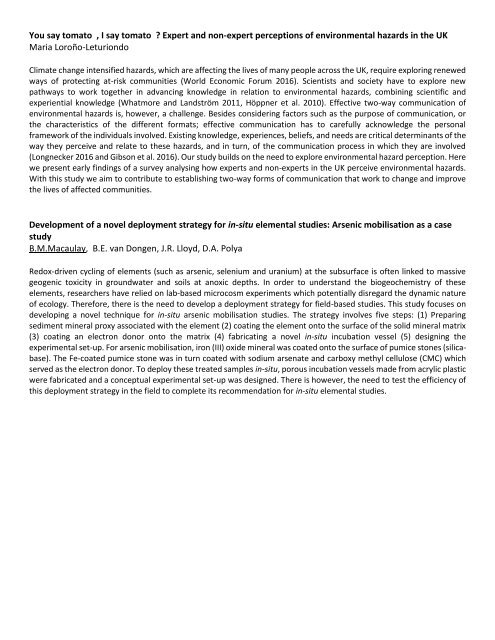Conference Programme FULL (1)
You also want an ePaper? Increase the reach of your titles
YUMPU automatically turns print PDFs into web optimized ePapers that Google loves.
You say tomato , I say tomato ? Expert and non-expert perceptions of environmental hazards in the UK<br />
Maria Loroño-Leturiondo<br />
Climate change intensified hazards, which are affecting the lives of many people across the UK, require exploring renewed<br />
ways of protecting at-risk communities (World Economic Forum 2016). Scientists and society have to explore new<br />
pathways to work together in advancing knowledge in relation to environmental hazards, combining scientific and<br />
experiential knowledge (Whatmore and Landström 2011, Höppner et al. 2010). Effective two-way communication of<br />
environmental hazards is, however, a challenge. Besides considering factors such as the purpose of communication, or<br />
the characteristics of the different formats; effective communication has to carefully acknowledge the personal<br />
framework of the individuals involved. Existing knowledge, experiences, beliefs, and needs are critical determinants of the<br />
way they perceive and relate to these hazards, and in turn, of the communication process in which they are involved<br />
(Longnecker 2016 and Gibson et al. 2016). Our study builds on the need to explore environmental hazard perception. Here<br />
we present early findings of a survey analysing how experts and non-experts in the UK perceive environmental hazards.<br />
With this study we aim to contribute to establishing two-way forms of communication that work to change and improve<br />
the lives of affected communities.<br />
Development of a novel deployment strategy for in-situ elemental studies: Arsenic mobilisation as a case<br />
study<br />
B.M.Macaulay, B.E. van Dongen, J.R. Lloyd, D.A. Polya<br />
Redox-driven cycling of elements (such as arsenic, selenium and uranium) at the subsurface is often linked to massive<br />
geogenic toxicity in groundwater and soils at anoxic depths. In order to understand the biogeochemistry of these<br />
elements, researchers have relied on lab-based microcosm experiments which potentially disregard the dynamic nature<br />
of ecology. Therefore, there is the need to develop a deployment strategy for field-based studies. This study focuses on<br />
developing a novel technique for in-situ arsenic mobilisation studies. The strategy involves five steps: (1) Preparing<br />
sediment mineral proxy associated with the element (2) coating the element onto the surface of the solid mineral matrix<br />
(3) coating an electron donor onto the matrix (4) fabricating a novel in-situ incubation vessel (5) designing the<br />
experimental set-up. For arsenic mobilisation, iron (III) oxide mineral was coated onto the surface of pumice stones (silicabase).<br />
The Fe-coated pumice stone was in turn coated with sodium arsenate and carboxy methyl cellulose (CMC) which<br />
served as the electron donor. To deploy these treated samples in-situ, porous incubation vessels made from acrylic plastic<br />
were fabricated and a conceptual experimental set-up was designed. There is however, the need to test the efficiency of<br />
this deployment strategy in the field to complete its recommendation for in-situ elemental studies.


